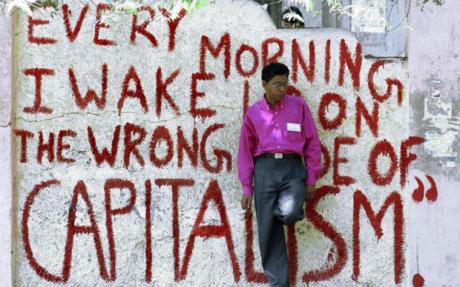via Harry Targ @ –> Heartland Radical
 Mitch Daniels knows a few things about finances and managing a budget. He was director of the Office of Management and Budget under President George W. Bush, president of Eli Lilly and Company’s North American Pharmaceutical, governor of Indiana, and currently president of Purdue University. …
Mitch Daniels knows a few things about finances and managing a budget. He was director of the Office of Management and Budget under President George W. Bush, president of Eli Lilly and Company’s North American Pharmaceutical, governor of Indiana, and currently president of Purdue University. …
Daniels spoke about the harmful impact of unbridled spending on Medicare, Medicaid, and Social Security during an on-camera interview with FreeEnterprise.com following his remarks on the same topic at the U.S. Chamber of Commerce Foundation’s Business Horizons entitlement reform program. (“Mitch Daniels: Entitlement Spending Is ‘Hurting Economic Growth’ ” FreeEnterprise.com, September 25, 2013)
In a fascinating essay entitled “Neoliberalism and Globalization,” Cliff Durand (Durand and Steve Martinot editors, Recreating Democracy in a Globalized State, Clarity Press, 2012), likens the capitalist system to the old board game “Monopoly” which most of us played when we were kids. He reminds older readers and informs younger ones that all the players begin the game with equal amounts of currency, move pieces along the board, and buy and sell property. Players accumulate wealth or suffer economic loss (even going to jail) depending on which squares they land on based on the roll of the dice.
To win the game of Monopoly, a player must buy up all the properties, purchase all the hotels, and accumulate all the money, stocks, and bonds. Durand continues: “You win by bankrupting the other players, forcing them to pay rent every time they land on your property. You win by driving them into destitution so they can no longer continue to play.”
Durand’s central point which is critical to reality today is that: “This is a zero sum game; what one wins is at the expense of another. This is a game in which each is to be guided by self-interest alone.” Compassion for a player under financial stress may impair the desperate drive to accumulate all the wealth the board game affords. Therefore, any collaboration between players in the game is merely temporary and is motivated only by the desire to win all the wealth.
In the United States, from the era of the New Deal until the 1970s and from the end of colonialism all across Asia, Africa, the Middle East, and, in a sense, Latin America until the rise of neoliberalism, wealthy classes and powerful nations saw the need to temporarily partner with adversaries, not out of compassion but out of interest. With the collapse of the New Deal coalition in the United States in the 1970s, the Non-Aligned Nations in the 1980s, and the Socialist Bloc in the early 1990s, capitalist institutions such as banks and transnational corporations launched a massive economic, military, and political campaign to bankrupt all sectors of all societies.
Let’s be clear: the capitalist system that was once forced to engage in reform is now on track to bankrupt and starve the vast majority of the world’s people. Workers in virtually every level of society, global, national, and local, are being economically marginalized and politically disenfranchised. Meanwhile the natural environment is being destroyed. The rich and powerful live in mansions in gated communities surrounding ponds and streams, protected by private security, and send their children to high-priced private schools.
At the global level, about 200 financial and industrial corporations control about a third of the value of all that is produced in the world. The one hundred largest economic actors in the world include 52 corporations and 48 nation-states. WalMart has risen to the 19th largest economic actor in the world.
And on the other hand, a recent UNICEF study reports on continuing, if not growing, global economic inequality, The top 20 percent of the world’s population controls 70 percent of total income while the bottom fifth account for 2 percent. Fifty percent of children and youth live below internationally recognized poverty rates. The middle income countries are the most unequal: the former Soviet Bloc, and countries in Asia experiencing the greatest increase in income inequality. Even though Latin America has experienced declining income inequality, it remains the region with the greatest levels of inequality.
The report makes a critical point: “Overall, the extreme inequality in the distribution of the world’s income should make us question the current development model (development for whom?) which has accrued mostly to the wealthiest billion. Not only does inequality slow economic growth, but it results in health and social problems and generates political instability.” (Isabel Irtiz and Matthew Cummins, “Global Inequality: Beyond the Bottom Billion: A Rapid Review of Income Distribution in 141 Countries,” UNICEF, April, 2011).
Looking at the United States, the picture is almost as grim. Mark Gongloff reviews a recent study of income inequality in the United States by economists Facundo Alvaredo, Anthony B. Atkinson, Thomas Piketty, and Emmanuel Saez. The top one percent of income earners have doubled their share of income since the 1970s to 20 percent. Growing income inequality in the United States since 1960 is significantly greater than all developed countries. U.S. income inequality is bested only by Chile, Mexico, and Turkey among all nations. Gongloff attributes growing income inequality in the United States to long years of reduced taxes for the rich and financial deregulation. “The same politicians that have busily been slashing taxes on the wealthy have also been loosening fetters on banking, allowing the financial sector to swell to bloated size and mop up ever-more income while contributing ever-less back to the economy.” (Mark Gongloff, “The U.S. Has the Worst Income Inequality in the Developed World, thanks to Wall Street: A Study” Huffington Post, August 15, 2013).
Looking at just one state, Indiana, suggests that local economic trends mirror the accumulation of wealth on one side and poverty on the other. In fact, Indiana has been one of the worst states in terms of providing for its working population. Almost 16 percent of the state’s population lives in poverty, including over 22 percent of its children, 17 percent of women, 33 percent of African Americans, 29 percent of Latinos, and 25 percent of Native Americans. One third of Indiana residents are low income and for a decade have experienced a decline in median household income. Even with a recent slight decline in the rate of poverty, the number of low income Hoosiers has risen since 2011. (Indiana Institute for Working Families, 9/19/13; sited in “Slight Decrease in Poverty Offset by Increase in Low-Income Hoosiers,” Lafayette Independent, October, 2013).
In an illuminating series on “The Unequal State of America: a Reuters Series,” by Deborah Nelson and Himanshu Ojha, December 18, 2012, www.reuters.com/subjects/income-inequality) the authors report on state-by-state trends in the U.S. economy from 1989 through 2010. Among their findings are the following:
*Inequality has increased in 49 of 50 states.
*The poverty rate increased in 43 states, most sharply in Nevada and Indiana.
*In all 50 states, the richest 20 percent of households made the greatest economic gains of any quintile.
As to tax policy over the last several years, the rich were the main beneficiaries. Nelson and Ojha site a Tax Policy Center finding “…that two-thirds of the tax savings would go to the top quintile of households and 1 percent to the lowest quintiles in 2012. In dollar savings, that’s $371,000 for the top 0.1 percent of households in 2012, $958 for the middle and $66 for the poor.”
So we must remember that when politicians (whether they are currently in office or using other visible institutional positions such as Purdue University President Mitch Daniels) warn of the need to “cut entitlements” to reduce “unbridled spending,” what they are talking about is blocking the necessary redistribution of the wealth of society for the benefit of the bottom ninety percent of the population. In addition, what they are really advocating is the enhancement of the wealth and income of the superrich.
And it is useful to remember also that the logic of the prevailing global and national economic system works like the old Monopoly board game; the object is to amass all the wealth on the board and to bankrupt all the other players.




